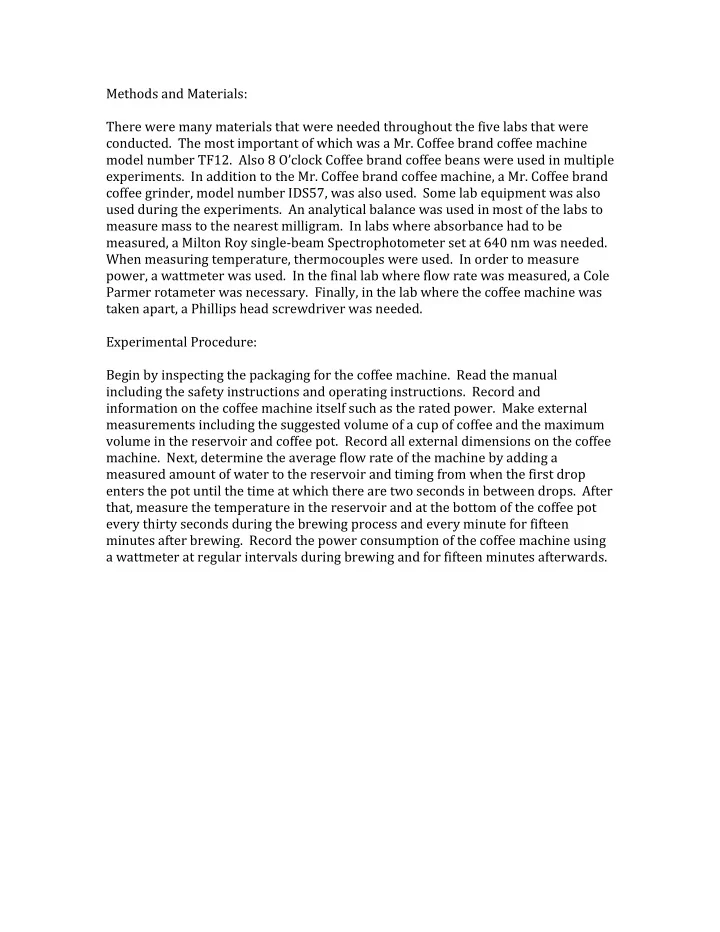

!"#$%&'()*&(!)#"+,)-'.( ( /$"+"(0"+"(1)*2(1)#"+,)-'(#$)#(0"+"(*""&"&(#$+%34$%3#(#$"(5,6"(-)7'(#$)#(0"+"( 8%*&38#"&9((/$"(1%'#(,1:%+#)*#(%5(0$,8$(0)'()(!+9(;%55""(7+)*&(8%55""(1)8$,*"( 1%&"-(*317"+(/<=>9((?-'%(@(AB8-%8C(;%55""(7+)*&(8%55""(7")*'(0"+"(3'"&(,*(13-#,:-"( "D:"+,1"*#'9((E*()&&,#,%*(#%(#$"(!+9(;%55""(7+)*&(8%55""(1)8$,*"F()(!+9(;%55""(7+)*&( 8%55""(4+,*&"+F(1%&"-(*317"+(EGHIJF(0)'()-'%(3'"&9((H%1"(-)7("K3,:1"*#(0)'()-'%( 3'"&(&3+,*4(#$"("D:"+,1"*#'9((?*()*)-2#,8)-(7)-)*8"(0)'(3'"&(,*(1%'#(%5(#$"(-)7'(#%( 1")'3+"(1)''(#%(#$"(*")+"'#(1,--,4+)19((E*(-)7'(0$"+"()7'%+7)*8"($)&(#%(7"( 1")'3+"&F()(!,-#%*(L%2(',*4-"M7")1(H:"8#+%:$%#%1"#"+('"#()#(NOP(*1(0)'(*""&"&9(( Q$"*(1")'3+,*4(#"1:"+)#3+"F(#$"+1%8%3:-"'(0"+"(3'"&9((E*(%+&"+(#%(1")'3+"( :%0"+F()(0)##1"#"+(0)'(3'"&9((E*(#$"(5,*)-(-)7(0$"+"(5-%0(+)#"(0)'(1")'3+"&F()(;%-"( R)+1"+(+%#)1"#"+(0)'(*"8"'')+29((<,*)--2F(,*(#$"(-)7(0$"+"(#$"(8%55""(1)8$,*"(0)'( #)C"*():)+#F()(R$,--,:'($")&('8+"0&+,6"+(0)'(*""&"&9( ( SD:"+,1"*#)-(R+%8"&3+".( ( T"4,*(72(,*':"8#,*4(#$"(:)8C)4,*4(5%+(#$"(8%55""(1)8$,*"9((L")&(#$"(1)*3)-( ,*8-3&,*4(#$"(')5"#2(,*'#+38#,%*'()*&(%:"+)#,*4(,*'#+38#,%*'9((L"8%+&()*&( ,*5%+1)#,%*(%*(#$"(8%55""(1)8$,*"(,#'"-5('38$()'(#$"(+)#"&(:%0"+9((!)C"("D#"+*)-( 1")'3+"1"*#'(,*8-3&,*4(#$"('344"'#"&(6%-31"(%5()(83:(%5(8%55""()*&(#$"(1)D,131( 6%-31"(,*(#$"(+"'"+6%,+()*&(8%55""(:%#9((L"8%+&()--("D#"+*)-(&,1"*',%*'(%*(#$"(8%55""( 1)8$,*"9((U"D#F(&"#"+1,*"(#$"()6"+)4"(5-%0(+)#"(%5(#$"(1)8$,*"(72()&&,*4()( 1")'3+"&()1%3*#(%5(0)#"+(#%(#$"(+"'"+6%,+()*&(#,1,*4(5+%1(0$"*(#$"(5,+'#(&+%:( "*#"+'(#$"(:%#(3*#,-(#$"(#,1"()#(0$,8$(#$"+"()+"(#0%('"8%*&'(,*(7"#0""*(&+%:'9((?5#"+( #$)#F(1")'3+"(#$"(#"1:"+)#3+"(,*(#$"(+"'"+6%,+()*&()#(#$"(7%##%1(%5(#$"(8%55""(:%#( "6"+2(#$,+#2('"8%*&'(&3+,*4(#$"(7+"0,*4(:+%8"''()*&("6"+2(1,*3#"(5%+(5,5#""*( 1,*3#"'()5#"+(7+"0,*49((L"8%+&(#$"(:%0"+(8%*'31:#,%*(%5(#$"(8%55""(1)8$,*"(3',*4( )(0)##1"#"+()#(+"43-)+(,*#"+6)-'(&3+,*4(7+"0,*4()*&(5%+(5,5#""*(1,*3#"'()5#"+0)+&'9( ( (
Results and Discussion: Experiment 1 : Mass Transfer: Particle Size The results calculated in this lab focused on concentration that is dependent on the particle size of the coffee beans. To determine how finely ground the beans were, the time that they were being ground for was recorded. After that, the coffee was brewed and the following results were collected: Average Concentration vs. Grinding Time 9 -i 8 - ^ Is 7 - c ^ — • _ , — • ^ 6 - ^^^~' ra •£ 5 - .1981X + 0.9411^-^ Si 4 - o A •^ - "^^"^ u 3 . ^^ -~~^^ A jfjp- ^-^ ~ 01 DO -— -^^" * 2 - n ^ iif-- ^ pj 0) ^^^H*"^"*^ > 1 J 0 . ^ 0 5 10 15 20 25 30 35 Grinding Time (s) This graph was plotted using data points for average concentrations in relation to the grinding times it corresponds to. Though it is not obvious, there does seem to be a direct linear relationship between these two values. This graph makes sense because the concentration of the coffee should increase as the grinding time increases. A longer grinding time provides more time for the surface area of the coffee beans to increase and concentration is maximized as surface area is maximized. The concentrations are average values because there were two calculated concentrations for every length of grinding time. The data may not seem very precise, but it is fairly accurate and consistent.
had a volume of around 140mL which means that each of our cups is 4.7 fl oz which is only a little more than half of the standard. When the coffee machine was filled, it was filled with 1L of water. However there is a final accumulated total of 872mL. This means that some water had to have been absorbed in the remaining coffee grounds or it had to have evaporated. As the coffee brewed in the pot, the temperature steadily increased until it reached a point where it remained constant. Temperature vs. Time 85 1E-07X 3 - O.OOOlx 2 + 0.0694X + 69.5 DO <U o f 8. 60 200 1400 400 (secon 100 ° 120 ° The reason that this graph uses a polynomial trend line is because Excel is unable to create a logarithmic trend line, which would be more appropriate for this data. The average power consumption of this machine is about 860 watts, which it used constantly during the brewing process and at two and a half minute intervals during the warming process.
Conclusion: Over the course of the five labs that were conducted many things were determined. In the first lab, we found how the time spent grinding the coffee beans effected the strength of the brewed coffee. From the data collected we can see that the more time spent grinding the coffee beans the stronger the coffee tends to be. We can see this not only from the taste test but also from the absorbance and concentration values for the different grind times. In the second lab that was conducted we determined that the strength of the coffee brewed also has to do with how long the coffee has been brewing for. This is displayed in the data, which shows that the first cup of coffee brewed has a much higher absorbance as well as a much higher taste rating than that of the last cup of coffee brewed. The third lab was different from the first two experiments. The external features of the coffee machine were examined as well as the operating specifications of temperature, flow rate, and power consumption. In this lab we learned a lot about how the coffee machine worked. In lab 4 we took it a step further by taking apart the coffee machine. This furthered our knowledge of how the coffee machine was put together and how it worked. We now knew that it used a tubular heating method to heat the coffee. We also discovered the way that the water flowed through the machine during brewing. In the last lab we investigated the relationship between water flow and outlet water temperature. From the data our group determined that when the flow rate is decreased the outlet temperature in much greater. From these five labs we were able to learn a lot about how a coffee machine works and what factors go into making a good cup of coffee. References: 1. Lim, Zack. "The Interesting Facts About Coffee Maker." Ezine Articles. Web. 12 Dec. 2010. <http://ezinearticles.com/7The-Interesting-Facts-About-Coffee- Maker&id=400585>. 2. Villanueva, Cristina M; Cantor, Kenneth P; King, Will D; Jaakkola, Jouni JK; Cordier, Sylvaine; Lynch, Charles F; Porru, Stefano; Kogevinas, Manolis [2006). "Total and specific fluid consumption as determinants of bladder cancer risk". International Journal of Cancer 118 (8): 2040-47.
Recommend
More recommend